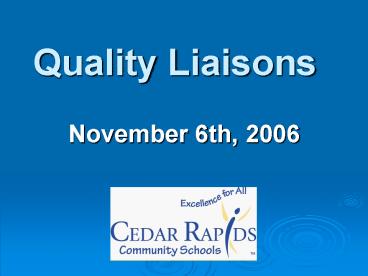Quality Liaisons - PowerPoint PPT Presentation
1 / 30
Title:
Quality Liaisons
Description:
4. Study research-based best practice/improvement theory addressing areas of need ... Worksheets & games isolate skills. State tests divided by content area ... – PowerPoint PPT presentation
Number of Views:25
Avg rating:3.0/5.0
Title: Quality Liaisons
1
Quality Liaisons
- November 6th, 2006
2
Responsibilities of the Quality Liaison
- Main communication channel between the District
and school/department - Serve as a "PDSA/Action Research support person
for the school or department (to locate resources
and/or find answers to questions) - Keep the momentum of action research going
through discussions, conversations and sharing of
information to staff
3
Purposes of Liaison Network
- Learn and share best practices in PDSA/Action
Research and quality tool usage - Network with other liaisons to share ideas and
best practices - Learn from each other's expertise and experiences
and discuss how to deploy and enhance continuous
improvement efforts in CRCSD - Support the implementation of the 4 Quality
Levels at the school
4
Q.L. Lotus Responsibilities(Define what these
mean to you)
Quality Liaison
PDSA Action Research
Quality Classroom
Communication
Quality Tools
Resource (s)
Best Practices
StaffDevelopment
Support
Network
5
(No Transcript)
6
Radar Chart Observations
- What do the results show?
- Are there common patterns among Quality Liaisons?
7
Performing the duties of the Quality Liaison is
taking the road less traveled
8
Learning From Dramatically Improved Schools!
9
Reading Test Scores - Brazosport ISD
98
96.6
93.9
White
93.8
92.3
82
Hispanic
All Students
African American
70
64
60
Economically Disadvantaged
50
10
Writing Test Scores - Brazosport ISD
98
96.7
White
95.6
All Students
94.1
93.2
Hispanic
80
Economically Disadvantaged
70
African American
60
59
57
9192
9293
9394
9495
9596
9697
9798
9899
9900
11
Math - Aldine ISD
93.5
White
90.9
89.1
Hispanic
88.1
84. 4
All Students
56.2
African American
55.0
49.4
Economically Disadvantaged
47.2
42.2
9394
9495
9596
9697
9798
9899
9900
12
What The Successes Have in Common
- A total systems framework
- Aligned processes
- Data-driven decisions
- Strong leadership
- A customer focus
13
- When school districts apply the principles and
techniques of continuous improvement over time,
positive and lasting changes in all parts of the
system (including student learning) are dramatic.
14
Why Quality and Continuous Improvement?
- Answer Its Research Based!
15
Whats happening at the next ARDT meeting?
- Continuing the PDSA Cycle
16
- Pre Planning Identification of Need
- 1. Develop/Review Student Learning Expectations
- 2. Examine alignment of learning expectations
with assessments - 3. Review assessment data
- 4. Identify areas of need based on assessment
- Plan
- 1. Describe the current process for addressing
the identified area of need (flow chart) - 2. Review data to determine baseline performance
in the specific area identified - (Run Chart/Pareto Diagram)
- 3. Identify potential root causes contributing
to the identified area of need - (Cause Effect Diagram, 5 Whys,
Relations Diagram) - 4. Study research-based best practice/improvement
theory addressing areas of need
Action Research Overview for Professional
Learning Communities
- DO
- 1. Plan for implementation of improvement theory
(Force Field Analysis, Action Plan) - 2. Implement research-based best practices
improvement theory based on root causes
according to the Action Plan - 3. Monitor the implementation of research-based
best practice/improvement theory to insure
integrity and fidelity4. Assess student learning
- Act
- 1. Standardize the implementation of
research-based best practice (improvement theory)
that improved student learning (revise the flow
chart to reflect changes made to the system) - 2. If improvement theory was unsuccessful
continue the PDSA cycle (try another improvement
theory based on the next identified root causes)
Study 1. Examine student assessment results
(compare to baseline) 2. Assess the impact of
research-based best practice/improvement theory
on student achievement
17
Identifying Root Cause!
- 3 Quality Tools
- Cause and Effect Diagram
- Relations Diagram
18
Cause Effect
19
Cause Effect Diagram
- How is it made?
- 1. Identify the problem.
- 2. Record the problem statement.
- 3. Draw and label the main bones.
- 4. Brainstorm for problem causes.
- 5. Identify the most likely cause
candidates.
20
Low Integration of State Test Objectives Across
Curriculum Areas
21
(No Transcript)
22
Whats Next?
- After completing the Cause and Effect Diagram,
the Relations Diagram can help identify root
causes
23
Relations Diagram
24
Relations Diagram
- How is it made?
- 1. Clearly define the issue or problem.
- 2. Construct the diagram layout.
- 3. Analyze the relationships.
- 4. Count the arrows.
- 5. Identify the root causes and effects.
- 6. Study the final diagram.
25
2 / 1
The Teacher Was Mean
1/ 2
- Root causes are those factors or aspects of a
problem which primarily influence other factors
(arrows out)
Some Students Were Not Behaving
The Teacher Yelled At Us
3 / 0
0 / 3
Some Students Were Not Listening To The Teacher
In / Out
26
(No Transcript)
27
Root Cause Identified
- Once root cause is identified it is time to
select a research-based improvement theory
28
Prior to next meeting
- Share the Deployment Instrument with your
Building Leadership Team and discuss how it could
be used to - Provide support to your Action Research
Deployment Team - November 29/30
- Cause Effect
- Relations Diagram
29
Final Thoughts
- Questions?
- Comments?
- Meeting Evaluation
- Next Meeting- January 23rd, 2007
Thank you- Leaders of Continuous Improvement!
30
(No Transcript)































